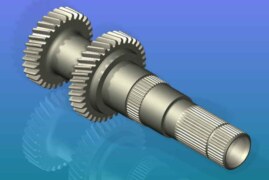3D printing enthusiasts often encounter some problems when using FDM 3d printing machine. Today we will take inventory, analyze the reasons and provide solutions.
01 Model drawing
When the nozzle is empty, the middle path does not need to extrude consumables. However, since the consumables before emptying are still not solidified, the thread will be pulled out. Especially in some models with more idling, there will be wire drawing.
When slicing, there is a “retract setting” function, that is, when the nozzle is empty, the material will be drawn back, and the material will be squeezed again when the empty running is over to resume normal feeding. The amount of consumables withdrawn in this process is the amount of withdrawn in the setting function. When there is wire drawing, you should set the appropriate draw-back amount according to your own machine drawing condition, the idling condition of the 3d printed model, the temperature of the nozzle and the air volume of the cooling fan.
02 Model hanging/drop
In large-angle printing, if there is no support, the underside of the overhanging protrusion will sag or even fall due to the influence of gravity during printing.
When the overhang angle is large, the corresponding support can be designed in the modeling. It is also possible to add support through slicing to solve the problem of hanging threads. Compared with modeling, a more powerful support with less contact can be designed. Or adjust the direction of the model so that the angle between the overhanging part and the platform is greater than 60 degrees, and printing can be completed without support.
03 Model cracked fault
This kind of phenomenon is mainly caused by the weak bond between the layers. The reasons are as follows:
- ① If the layer height is set too high, the bonding of the material needs to be squeezed. If the layer height is too high, it will result in not squeezed or insufficient squeezing, and the adhesion will not be tight.
- ②Insufficient heating temperature and premature cooling of consumables. Consumables such as PLA and ABS are only viscous when they are in a liquid state. When the temperature is insufficient or the cooling is too fast, the surface of the consumables extruded by the nozzle will solidify and fail to bond.
For the above questions, you can target
- ①Reduce the height of the floor, it is recommended to set it at least less than half the diameter of the nozzle;
- ② Increase the nozzle temperature appropriately. We mentioned the relationship between the force direction and the printing direction in the previous issue. This is also the issue that needs to be paid attention to below.
04 The top layer of the model is not closed
This problem is similar to the part of the model falling problem, mainly because the lower support is insufficient, and the top layer has fallen. The possible reason is that the internal filling of the model is small, and the large-span wire without support will cause sagging, and the insufficient thickness of the top layer can not make up.
In this case, you can choose to increase the fill rate inside the model and increase the thickness of the top layer.
05 Model off the platform
This type of problem is mainly due to the insufficient adhesion between the model and the platform, which causes the following factors:
- ① The printing platform is not leveled properly. or
- ②There are particles and grease on the surface of the printing platform. It can be solved by cleaning the platform, re-leveling, and slightly reducing the distance between the platform and the nozzle. When it is difficult to level, you can use the bottom pad to make up for the error.
There are other possibilities
- ① When printing a model with a large contact area with the platform, due to excessive filling, the material has thermal expansion and contraction (the shrinkage rate of PLA is 0.2), and it is easy to warp and then separate from the printing platform.
- ②The model is too high and the bottom area is small, the print head may move and bring the model upside down when printing on high places.
The above phenomenon can be solved by the following work:
- ①When printing a model with a larger bottom area, you can apply glue on the platform to help stick it, and adjust the platform temperature to the recommended temperature of the equipment according to the material.
- ②When printing a model with a small bottom area, add the edge when slicing to enlarge the contact area.
06 The bottom of the model is warped
The main problem is that the model and the platform are not sticky enough.
- ①The distance between the nozzle and the platform is large when leveling, and the consumables are not squeezed and glued on the platform;
- ②The temperature of the nozzle and hot bed is insufficient, and the surface of the consumables is prematurely cooled and loses viscosity during extrusion;
- ③The contact area of the bottom is large, and the material shrinks.
For this problem, you should check the leveling first, and select the corresponding temperature according to the consumable material. For models with a larger bottom area, you can also choose to use glue and reduce the filling rate of the bottom surface.


